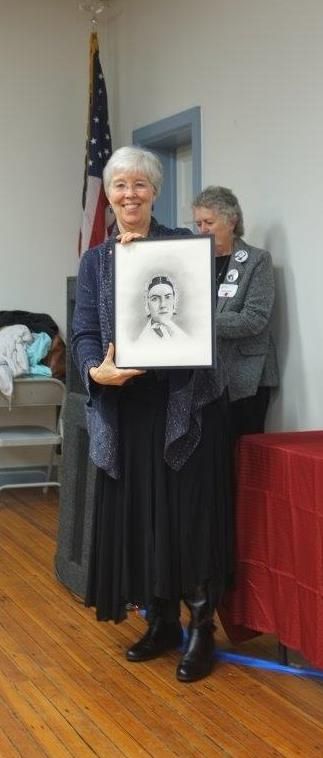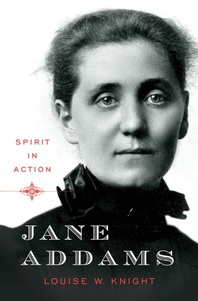|

Grimke Related News I recently selected a letter by Angelina Grimke on women's rights, written in 1837, for publication on the Lapham Quarterly blog. It is wonderful reading. On October 22, 2016 Angelina Grimke was inducted into the National Abolition Hall of Fame, in Peterboro, NY. I was honored to nominate her. ***** Do you want to hear a portion of a speech by Angelina Grimke? Actor Anne Gottlieb has brought Angelina to life. Go to 11:41 on this link to listen to the short clip. --- In the spring of 2015 I gave a talk at Shimer College on Sarah Grimke and the feminist tradition -- it is on YouTube! My bio entry on Thomas Smith Grimke, brother of Angelina and Sarah, is on the American National Biography Online website. In researching the above entry about Thomas Grimke, I faced a challenge -- how to find an image of him? Here is the story. posted on the Oxford University Press blog. Visiting Charleston, SC? Take the Grimke Sisters Tour! And consider a visit to the historic marker in front of the Grimke sisters' home. WATCH A VIDEO of Angelina Grimke giving a speech! Well, actually it is an actress performing a speech (a part of it) . In February 1838, Angelina gave a powerful address to a committee of the Massachusetts state legislature, with an enormous crowd of people gathered to hear it (it was that unusal that a woman would give a speech). She and Sarah had spent the summer supporting a campaign in Massachusetts to collect women's signatures on petitions to Congress to end slavery in the District of Columbia. She was now presenting the petitions to the committee, to ask the state legislature to send the petitions forward to Congress (they declined). An actress, Anne Gottlieb, performed the (short) surviving portion of it, at an event in Boston in October 2013. It is well worth watching. The speech is brilliant and so is Gottlieb's performance, which begins at 11:03. |
Other news:
----- ANGELINA GOES TO WASHINGTON: A few years ago the National Portrait Gallery recognized Angelina Grimke's place in the history of the women's suffrage movement in its exhibit on " Votes for Women: A Portrait of Resistance - March 29, 2019 through January 5, 2020." The photo of her family that the Clements Library loaned to the Gallery was taken in 1850 and it shows Angelina does not have a face as peculiar as the one shown in the famous (bad) drawing of her in general circulation. To see photos of the sisters (these were taken when they were in their 60s or so) and compare them to the bad drawings, go to "More..." in the upper right and click on "About the Grimke sisters." or Click here. By the way, the image of Angelina on the left, that I am holding, is an original drawing based loosely on the 1850 photograph. Why was Angelina being honored? Because she was the first woman in US history to call for and enact women's full citizenship. She was the first woman to address a legislative body, in 1838, and in that speech, said that a woman had as much right to be the president of the United States as a man. Sarah Grimke, her sister, also should be equally honored, to be sure. She wrote the first book to argue for women's full equality, Letters on the Equality of the Sexes, which was first published (as a newspaper series) in 1837. It is Sarah Grimke's famous words that are quoted in the documentary "RBG" by Justice Ginsburg and in the film, "On Account of Sex," at the very end, again, by Justice Ginsburg. It is her favorite quote. Sarah wrote, "All I ask of our brethren is that they take their feet off our necks." The Grimkes and Ruth Bader Ginsburg: In the wonderful movie about Judge Ginsburg, "RBG," to be aired on CNN on Sept. 3, 2018, she quotes Sarah Grimke at the beginning and again in the middle. The judge is a Sarah Grimke fan! Here is my piece on CNN.com about Ginsburg and Grimke. And this is a good summary of the movie that ends with a fresh quote (not used in film) of Sarah Grimke. My new essay on Angelina captures a bit of her feistiness. Why do I write my books? I gave some answers in this recent interview. Ruth Bader Ginsburg quotes Sarah Grimke! The sisters, born in Charleston, S.C. to a wealthy slaveowning family, fled north in the 1820s to Philadelphia to escape life in a slave state and a home with slaves as servants. But their horror at slavery did not translate into social action until the new, immediate abolition movement persuaded them that the institution of slavery could end. They joined the campaign, lecturing widely, organizing abolition societies and gathering petition signatures on slavery. They were the first American women to travel, lecture and organize for a secular cause. Growing up in the early part of the nineteenth century, the ambitious and brilliant sisters were blocked by society's narrow expectations for women. They were denied formal education and all careers except teaching were closed to them. Eventually, both sisters aspired to be ministers, even though their own Episcopal Church, like most Protestant denominations, forbade women from that profession. Religiously restless, the sisters were drawn, after converting to Presbyterianism for a time, to become Quakers in part because of its tradition of women ministers. But they did not find encouragement among the Quakers either. The abolition movement, however, welcomed the Grimkes,who were the only Southern women to become abolitionists. The opportunities the movement gave them and its emphasis in these years on human rights helped the sisters reinterpret their lives as women, while friendships with African American Quaker abolitionists deepened their understanding of racism. Transformed by the radicalism of the decade of the 1830s and by their own courage to live according to their consciences, the sisters spent almost three years in speeches and published writings, making the case to end slavery and racial and female oppression. Below is the elegant doorway to the four story house in Charleston where they grew up. For more about the sisters, see "About the Grimké sisters" and the Women's History Blog, which has a speech Angelina gave to a committee of the Massachusetts state legislature in 1838. In doing so, she became the first American woman to address a legislative body. |
 Jane Addams: Spirit in Action (W.W. Norton, 2010)
Jane Addams: Spirit in Action (W.W. Norton, 2010)
